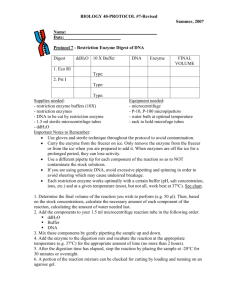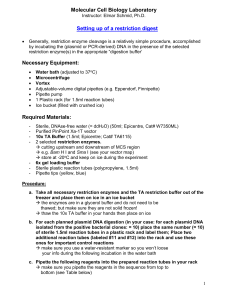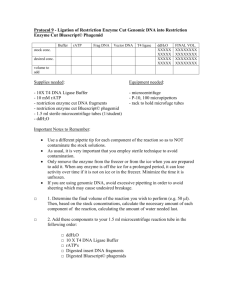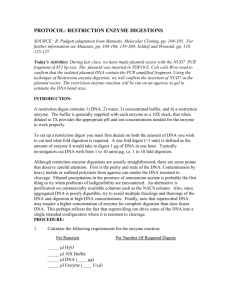doc
advertisement
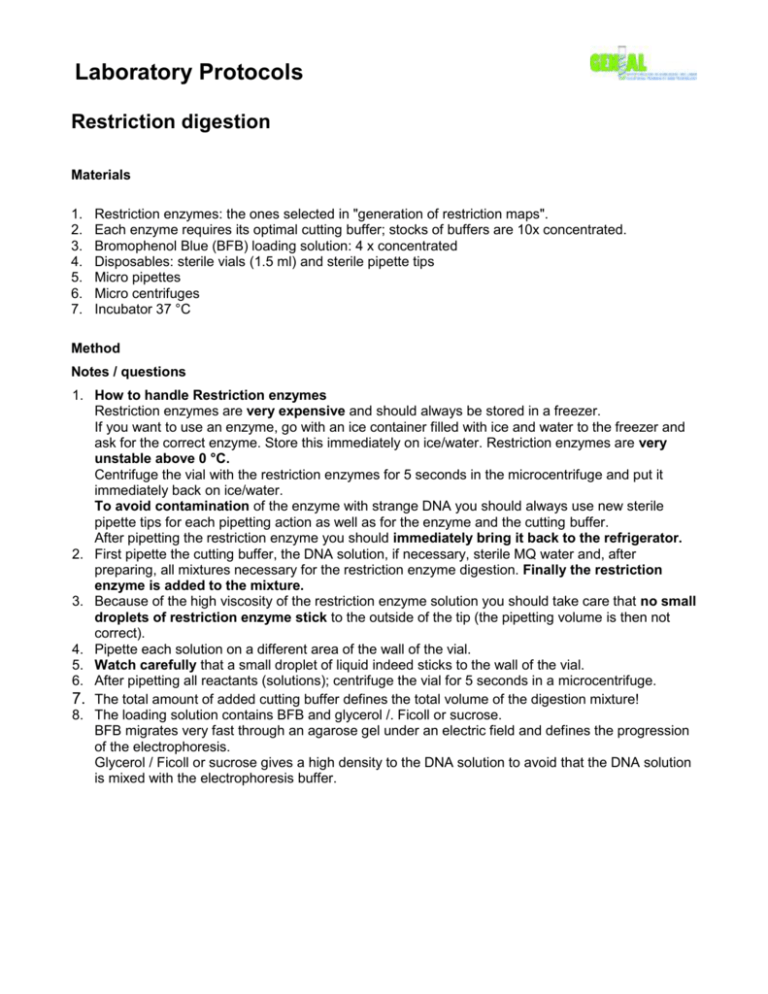
Laboratory Protocols Restriction digestion Materials 1. 2. 3. 4. 5. 6. 7. Restriction enzymes: the ones selected in "generation of restriction maps". Each enzyme requires its optimal cutting buffer; stocks of buffers are 10x concentrated. Bromophenol Blue (BFB) loading solution: 4 x concentrated Disposables: sterile vials (1.5 ml) and sterile pipette tips Micro pipettes Micro centrifuges Incubator 37 °C Method Notes / questions 1. How to handle Restriction enzymes Restriction enzymes are very expensive and should always be stored in a freezer. If you want to use an enzyme, go with an ice container filled with ice and water to the freezer and ask for the correct enzyme. Store this immediately on ice/water. Restriction enzymes are very unstable above 0 °C. Centrifuge the vial with the restriction enzymes for 5 seconds in the microcentrifuge and put it immediately back on ice/water. To avoid contamination of the enzyme with strange DNA you should always use new sterile pipette tips for each pipetting action as well as for the enzyme and the cutting buffer. After pipetting the restriction enzyme you should immediately bring it back to the refrigerator. 2. First pipette the cutting buffer, the DNA solution, if necessary, sterile MQ water and, after preparing, all mixtures necessary for the restriction enzyme digestion. Finally the restriction enzyme is added to the mixture. 3. Because of the high viscosity of the restriction enzyme solution you should take care that no small droplets of restriction enzyme stick to the outside of the tip (the pipetting volume is then not correct). 4. Pipette each solution on a different area of the wall of the vial. 5. Watch carefully that a small droplet of liquid indeed sticks to the wall of the vial. 6. After pipetting all reactants (solutions); centrifuge the vial for 5 seconds in a microcentrifuge. 7. The total amount of added cutting buffer defines the total volume of the digestion mixture! 8. The loading solution contains BFB and glycerol /. Ficoll or sucrose. BFB migrates very fast through an agarose gel under an electric field and defines the progression of the electrophoresis. Glycerol / Ficoll or sucrose gives a high density to the DNA solution to avoid that the DNA solution is mixed with the electrophoresis buffer. Laboratory Protocols Single digestion: DNA is cut with one restriction enzyme 1. 2. 3. 4. 5. 6. 7. 8. Take the DNA samples from the refrigerator and let them thaw on ice/water. Into a sterile clean vial (1.5 ml), pipette the following solutions on different areas of the plastic wall of the same vial: - 2 l 10x cutting buffer (so the final volume of the mixture = … l) - 10 l DNA solution - 19 – (2 + 10) = 7 l sterile MQ water and finally - 1 l selected restriction enzyme Total volume of the digestion mixture = …. l (Remark: if you use X l cutting buffer; the final volume of the digestion mixture = 10* X l) Centrifuge the vials for 5 seconds to mix the content of the vials The remaining DNA solution is stored in the freezer and can be used for a PCR experiment. Incubate the vials for one hour at 37 °C. How much bromophenol blue must be added immediately after finishing the incubation period? We use a 4x concentrated BFB loading solution; this means that to 3 volumes of digestion mixture 1 volume of BFB loading solution is added. (Remark: if a 6x concentrated BFB loading solution is used, then the ratio is: to 5 volumes of digestion mixture add 1 volume of BFB loading). Volume of 4x concentrated BFB loading solution = 20/3 = 6.66 l The total volume should be applied to a well on an agarose gel for agarose gel electrophoresis. Remark: during the digestion period an agarose gel can be prepared; see below. Double digestion: DNA is cut with two restriction enzymes 1. 2. 3. 4. 5. 6. Take the DNA samples from the refrigerator and let them thaw on ice/water. Into a sterile clean vial (1.5 ml), pipette the following solutions on different areas of the plastic wall of the same vial: - 2 l 10x cutting buffer (so the final volume of the mixture = … l) - 10 l DNA solution - 18 – (2 + 10) = 6 l sterile MQ water and finally - 1 l selected restriction enzyme A - 1 l selected restriction enzyme B Total volume of the digestion mixture =. l (Remark: Take particular care with the choice of the cutting buffer; choose a buffer that is appropriate for both enzymes. Sometimes it is necessary to digest the DNA with the first restriction enzyme; then to correct the ion strength of the mixture, followed by the incubation with the second enzyme. In the worst case you must remove the first enzyme, clean up the DNA and then perform the second incubation). Incubate the vials for one hour at 37 °C. The remaining DNA solution is stored in the freezer and can be used for a PCR experiment. After incubation: 20/3 = 6.66 l 4x concentrated BFB loading solution is added. The total volume should be applied to a well on an agarose gel for agarose gel electrophoresis.

